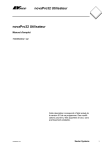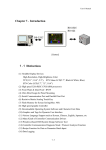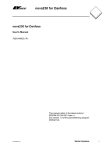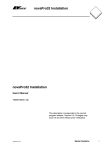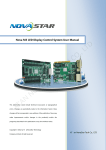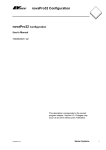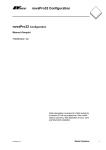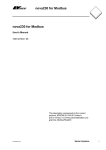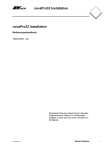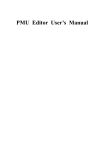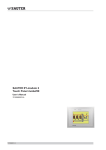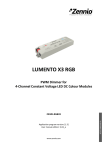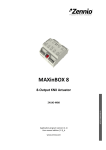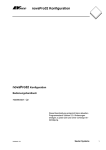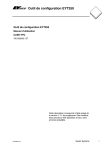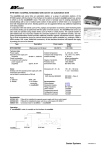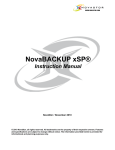Download novaPro32 Users novaPro32 Users
Transcript
novaPro32 Users novaPro32 Users User's Manual 7000894003 Q2 This description corresponds to the current program release, Version 5.0. Changes are taking place constantly, without prior notification. 7000894003 Q2 Sauter Systems 1 novaPro32 Users 2 7000894003 Q2 Sauter Systems novaPro32 Users 0 Table of contents 1 Introduction...............................................................................................................9 1.1 1.2 1.3 1.4 The documentation for novaPro32...................................................................10 System topology..............................................................................................11 System requirements.......................................................................................12 Structure of novaPro32....................................................................................12 2 Getting started ........................................................................................................15 2.1 Starting novaPro32..........................................................................................15 2.2 Close/shut down novaPro32............................................................................16 2.3 Data connection to an AS network...................................................................16 2.3.1 Direct access to the AS networks .............................................................17 2.3.2 Access via data network (LAN/WAN) .......................................................17 2.3.3 Access to the AS networks via modem.....................................................18 3 Security ...................................................................................................................19 3.1 3.2 3.3 Login ...............................................................................................................19 Logout .............................................................................................................20 Change password............................................................................................20 4 Alarm list .................................................................................................................21 4.1 Show alarm list ................................................................................................21 4.1.1 Alarm list display ......................................................................................21 4.1.2 Working with novaPro32 in the background..............................................22 4.2 Operating the alarm list....................................................................................23 4.2.1 The context menu.....................................................................................23 4.2.2 Acoustic alarms........................................................................................25 5 The novaPro32 browser .........................................................................................27 5.1 5.2 5.3 The document browser ....................................................................................28 The address browser.......................................................................................30 The system browser ........................................................................................31 6 Pictures ...................................................................................................................33 6.1 Calling up a novaPro32 picture........................................................................34 6.2 Functions in novaPro32 pictures......................................................................35 6.2.1 Acknowledging alarms .............................................................................36 6.2.2 Changing limit values ...............................................................................36 6.2.3 Changing setpoint values .........................................................................37 6.2.4 Commands...............................................................................................37 6.2.5 Control buttons.........................................................................................38 6.2.6 Call up an embedded object.....................................................................39 7 Protocols.................................................................................................................41 7.1 7.2 7.3 Creating a new protocol...................................................................................41 Saving a configuration .....................................................................................44 Calling up a pre-configured protocol ................................................................44 7000894003 Q2 Sauter Systems 3 novaPro32 Users 0 Table of contents 7.4 7.5 7.6 Printer selection .............................................................................................. 45 Printing a protocol ........................................................................................... 45 Exporting a protocol ........................................................................................ 46 8 Time programme .................................................................................................... 47 8.1 Create a new time programme ........................................................................ 48 8.1.1 Select address ......................................................................................... 48 8.2 Opening an existing time programme template ............................................... 50 8.3 Read a time programme from the AS .............................................................. 51 8.4 Edit a time programme .................................................................................... 51 8.4.1 Add a new command ............................................................................... 51 8.4.2 Change a time command ......................................................................... 52 8.4.3 Time command selection ......................................................................... 52 8.4.4 Entry in the list ......................................................................................... 55 8.4.5 Edit commands ........................................................................................ 55 8.5 House addresses with several time programmes ............................................ 55 8.6 Send to AS...................................................................................................... 56 9 Calendars................................................................................................................ 57 9.1 9.2 9.3 9.4 9.5 9.6 Create a new calendar .................................................................................... 58 Delete a calendar ............................................................................................ 59 Rename a calendar ......................................................................................... 59 Assign a special day........................................................................................ 59 Deleting a special day ..................................................................................... 60 Assign an AS to a calendar ............................................................................. 60 10 Historical database/Trend...................................................................................... 63 10.1 Show new HDB/Trend..................................................................................... 63 10.2 Open HDB/Trend ............................................................................................ 66 10.3 Working with HDB/Trend................................................................................. 67 10.3.1 Edit graphic zone .....................................................................................67 10.3.2 Edit table sector ....................................................................................... 68 10.3.3 Edit title and legend sector ....................................................................... 68 11 PC time programmes ............................................................................................. 71 11.1 Introduction ..................................................................................................... 71 11.1.1 Common functions ................................................................................... 71 11.1.1.1 Context menu ................................................................................... 71 11.1.1.2 Evaluating the created .txt files ......................................................... 73 11.1.1.3 Editing the viewed PC TP list ............................................................ 74 11.2 Automatic execution of protocols..................................................................... 75 11.2.1 Context menu........................................................................................... 75 11.2.2 The ‘Selection’ card.................................................................................. 75 11.2.3 The ‘Target’ card...................................................................................... 76 11.2.4 Evaluating the created txt files ................................................................. 77 4 7000894003 Q2 Sauter Systems novaPro32 Users 0 Table of contents 11.2.5 The ‘Selection’ card..................................................................................77 11.2.5.1 Once .................................................................................................77 11.2.5.2 Hourly ...............................................................................................78 11.2.5.3 Daily..................................................................................................78 11.2.5.4 Weekly..............................................................................................79 11.2.5.5 Monthly .............................................................................................79 11.3 Automatic download of AS time programmes ..................................................82 11.3.1 Context menu...........................................................................................82 11.3.2 The ‘Selection’ card..................................................................................83 11.3.3 The ‘Execution’ card.................................................................................84 11.4 Automatic HDB Export.....................................................................................85 11.4.1 Context menu...........................................................................................85 11.4.2 The ‘Selection’ card..................................................................................86 11.4.3 The ‘Target’ card ......................................................................................86 11.4.4 The ‘Execute’ card....................................................................................87 11.5 Automatic download of AS calendars ..............................................................89 11.5.1 Context menu...........................................................................................89 11.5.2 The ‘Selection’ card..................................................................................89 11.5.3 The ‘Execute’ card....................................................................................90 11.6 Automatic time synchronisation of AS..............................................................91 11.6.1 Context menu...........................................................................................91 11.6.2 The ‘Selection’ card..................................................................................91 11.6.3 The ‘Execute’ card....................................................................................92 12 Address list .............................................................................................................93 12.1 AS monitoring..................................................................................................94 12.2 Create an address list......................................................................................95 12.2.1 Open an address list ................................................................................95 12.2.2 Call up an address list from the alarm list .................................................96 12.2.3 Call up an address list from a picture........................................................96 12.3 Operation using the address list ......................................................................96 12.4 Print.................................................................................................................96 13 Remote monitoring and routel...............................................................................97 13.1 13.2 13.3 13.4 Introduction......................................................................................................97 Start / Stop of nP32 .........................................................................................97 Manual connections.........................................................................................98 Treatment of manual addresses ......................................................................99 14 Help and online documentation...........................................................................101 14.1 Calling up Help ..............................................................................................101 14.2 Read on screen .............................................................................................102 14.3 Print the manual ............................................................................................102 15 Index......................................................................................................................103 7000894003 Q2 Sauter Systems 5 novaPro32 Users 0 Table of contents List of icons and symbols Keyboard operation Wait diskette Mouse operation Single mouse click with left button Single mouse click with right button Double mouse click with left button Double mouse click with right button Description Application Information Attention Note 6 7000894003 Q2 Sauter Systems novaPro32 Users 0 Table of contents Trademarks Designer Micrografx Designer Media Manager Windows Microsoft Office 97 Professional MS Office Microsoft Access 97 Microsoft Office 2000 Microsoft Word Acrobat Reader Pentium 7000894003 Q2 Trademark of Micrografx, Inc. Trademark of Micrografx, Inc. Trademark of Micrografx, Inc. Trademark of Microsoft Corporation Trademark of Microsoft Corporation Trademark of Microsoft Corporation Trademark of Microsoft Corporation Trademark of Microsoft Corporation Trademark of Microsoft Corporation Adobe Systems Incorporated Trademark of Intel Corporation Sauter Systems 7 novaPro32 Users 0 8 Table of contents 7000894003 Q2 Sauter Systems novaPro32 Users 1 Introduction 1 Introduction novaPro32 comprises the management level of the EY3600 building management system. This system is extremely user-friendly because it is built up consistently on the basis of the Microsoft Windows operating system. The system's standard interfaces and network capability make it possible to integrate building automation into the office automation world. These pages provide users of the novaPro32 management system with an overview of the most important functions and how to use them. These instructions explain the major operating procedures in detail, but they deliberately do not cover the parameterisation of the system: in this respect, they are quite specifically intended for operating and service staff. 7000894003 Q2 Sauter Systems 9 novaPro32 Users 1 Introduction 1.1 The documentation for novaPro32 The operating instructions for novaPro32 are in three parts. Each part is intended for a quite specific user group. Part 1 User Manual Benutzerhandbuch Part 2 Part 3 Configuration Installation Commissioning ! ! ! PD ! PD PD T 1 Rev. PD PD T 1 T Rev. A B AB Operating staff Doc. No. 7 000894 003 1) Introduction 2) Getting started 3) Security/Login 4) Alarm list – operation 5) The novaPro32 browser 6) Pictures - operation 7) Protocols 8) Time programme 9) Calendar 10) HDB/Trend 11) PC time programme 12) Address list 13) Remote-island mode 14) Online documentation 10 7000894003 Q2 Installation design engineering Commissioning staff Doc. No. 7 000915 003 Maintenance staff Installation design engineering Doc. No. 7 000904 003 1) General 2) Generating passwords 3) Filters 4) Address groups 5) Event publisher server 6) Alarm list 7) Online messaging 8) Historic database 9) Dynamising pictures 10) Address list 11) Synchronisation – AS network 12) Printer 13) Copy Shareable_Data 14) Document master 15) Logbook 16) Help, Online documentation 1) 2) 3) 4) 5) 6) 7) 8) Introduction Hardware, software Installation The novaPro32 project Equipment table Networks Icon Maker Glossary Sauter Systems novaPro32 Users 1 Introduction 1.2 System topology The PC operating stations are connected directly to the system bus, or to one another via a LAN/WAN network. In this way, building management technology is fully integrated into a company's network infrastructure. A modem can be used to implement remote access to the installations via the public telecommunications network. Events and protocols can be forwarded on the basis of time and priority to a wide variety of destinations such as printers, faxes, pagers, paging systems and so on. Management level Fig.1-1: System topology The management level is used for operational management, and it handles the following main tasks: • process visualisation and monitoring • operation of the installation(s) • signal processing and alarming • logging and evaluation • higher-level management and optimisation functions • central archiving functions • long-term data storage 7000894003 Q2 Sauter Systems 11 novaPro32 Users 1 Introduction 1.3 System requirements HW requirements: PC: Processor: Working memory: Hard disk: Diskette drive: CD drive: Interfaces: INTEL Pentium II 233 MHz or better (400 MHz recommended) 192 MByte RAM (256 MByte recommended) min. 1.8 GB (depending on the installation size, 9 GB recommended) 3½ “ 1.44 MByte (to install the licence) for the installation 1 mouse, 1 serial, 1 ISA-Bus (optional for EYS290) 1 printer 1 network connection SW requirements: Windows NT 4 SP6a/2000 and XP MS-Office 97/2000 and XP (Designer 7 to generate vector graphics) For administration: MS-Access 97 1.4 Structure of novaPro32 The EY3600 novaPro32 system operating software is based on the operator-prompted, user-friendly Windows surface. The modular structure allows individual configuration of the system in relation to the customer's needs in each case. The customer only ever pays for the functionality he wants, but flexibility for future extensions to the system is retained. EY3600 novaPro32 is based on the MS Windows operating system, and it is a 32-bit application. The software offers a large number of powerful and efficient functions such as: • • • • • • • • • 12 7000894003 Q2 visualisation and operation using dynamic installation schematics or text windows alarm monitoring; an alarm journal is kept parameterisation and modification of the time and holiday programs for the automation stations display and output of freely definable protocols display and output of tables and graphics for historical data ‘Trend’ function to show ongoing data in graphic form logbook to log all system actions differentiated password protection, can be defined for each user events such as alarms, limit value violations, value changes, system messages and time- or event-controlled protocols are forwarded selectively to destinations of all types, such as screens, printers, fax, E-mail, files or pager systems. Sauter Systems novaPro32 Users 1 Introduction • • • 7000894003 Q2 multimedia ability opens up entirely new horizons for the display and output of events. For example, when a certain alarm occurs, a film can be shown automatically or a voice announcement can be activated. data exchange with all Windows programs. For example, an Excel table can be dynamised in an installation schematic or (in the opposite direction) novaPro process value dynamisations can be displayed in EXCEL. interfaces to integrate external systems Sauter Systems 13 novaPro32 Users 1 14 Introduction 7000894003 Q2 Sauter Systems novaPro32 Users 2 Getting started 2 Getting started 2.1 Starting novaPro32 Start novaPro32 by double-clicking on the icon that has been specially created for your project. All the necessary components will be loaded automatically. novaPro32 starts these programs in the background: Provider Î Provid.exe Event Publisher Server Î EPServer.exe Historical Database Server Î HDBServer.exe Fig. 2-1 novaPro32 start icon The start icon is specifically set up for your project on the PC by the design engineer. Program IconMaker.exe can be used to specify the precise start mode for novaPro32. After you have started novaPro32, open the novaPro32 Document Browser (see Chapter 5.1). novaPro32 appears as shown in Fig. 2-2 with the Browser on the left and the opened document on the right. Fig. 2-2 novaPro32 - Operating surface with Document Browser Please contact your System Administrator; he will be glad to give you more detailed information about the precise start configuration for your project. 7000894003 Q2 Sauter Systems 15 novaPro32 Users 2 Getting started 2.2 Close/shut down novaPro32 You can use the context menu (right-hand mouse button) for the index card of novaPro32 documents as a convenient way to close the documents (see Fig. 2-3). Fig. 2-3 Context menu of the index card for novaPro32 documents Shut novaPro32 down with the File/Shut down menu. ‘Shut down’ closes novaPro32 with all the sub-programs such as the Event Publisher Server and the HDB Server. After a ‘shutdown’, no more alarms are issued to reporting systems, such as printers; nor are data from the Historical database archived. The ‘Shut down’ function is only accessible to authorised users. 2.3 Data connection to an AS network novaPro32 supports the possibilities for communication with an AS network that are shown in Table1. Table1: Communication with an AS network A290: Connection via ISA-Bus Controller EYS 290. The ISA-Bus Controller EYS 290 is situated in your local PC, which therefore has a direct connection to the AS network. A291: Connection via novaNet-Router EYZ 291. The novaNetRouter EYZ 291 is directly connected to a serial interface of your local PC. Modem: Connection via the public telephone network to a novaNetRouter EYZ 291. The PC is fitted with a telephone modem, and it uses the public telephone network to establish a connection with a second modem which is directly connected to a novaNetRouter EYZ 291. DCOM: Connection via a data network (LAN/WAN). Your local PC uses a data network (LAN/WAN) to connect to a second PC (the Gateway), which has a direct connection to the AS network. 16 7000894003 Q2 Sauter Systems novaPro32 Users 2 Getting started 2.3.1 Direct access to the AS networks If your PC has direct access to the AS networks (A290 or A291), you need do nothing after you have started novaPro32. The data connection to these networks is established automatically. 2.3.2 Access via data network (LAN/WAN) This operating mode is now started via ‘Windows Sockets’. If your workstation uses an IT network (LAN/WAN, such as Ethernet, TCP/IP) to access a Gateway PC with a direct connection to the AS networks, novaPro32 will automatically establish a connection with the Gateway PC via the network connection after it has been started. The network server can also be run as a normal operating station. There is no starting order between network server and network client. The addresses are automatically logged on again after the network server has been stopped/started. If the connection is successful, the Windows task bar (bottom right) will show a ball icon. The colour of this ball tells you Fig. 2-4: about the status of the data connection between your An existing connection workstation (DCOM client) and the Gateway PC (DCOM server). See Table 2. Fig. 2-5 Double-click the ball to view the list of connections. Connection broken This list includes all the connected server PCs with the connection status and the time when the connection Fig. 2-6 was established or broken Fig. 2-7. Fig. 2-6 Fig. 2-7 Table 2:What the colours mean Colour Blue ball: Yellow exclamation mark: Means The connection between the workstation and the Gateway is OK. The connection between the workstation and the Gateway has been interrupted. Possible causes • • • 7000894003 Q2 The Gateway PC might not be operating. The network connection has been interrupted. Configuration error Sauter Systems 17 novaPro32 Users 2 Getting started 2.3.3 Access to the AS networks via modem You can use a normal commercial telephone modem to establish a connection between your PC and novaNet-Router EYZ291 via the public telephone network (see Fig. 2-8).1 Modem Rout Routel side Modem P C side ESC novaNet Router EYZ291 Fig. 2-8: Connection via modem Depending on the novaPro32 start configuration, the telephone connection to the AS network is established automatically, or else you have to make the connection manually via the ‘File | Connections...’ menu. To make the connection manually, the ‘Connections’ dialogue will appear on the screen (see Fig. 2-9). Click on the ‘Connect’ button to establish a data connection with the AS network. You can use the ‘Close’ button to terminate a data connection that already exists. novaPro32 logs off the AS addresses and the modem terminates the telephone connection to the AS island. Fig. 2-9: Establishing a connection with an AS island 1 Installation and configuration of the modem connection: see EY3600 novaPro32 Installation Manual. 7000915 001 18 7000894003 Q2 Sauter Systems novaPro32 Users 3 Security 3 Security novaPro32's functions are only accessible to authorised staff. A user identifies himself in the system with a user name and a password. The code word can be used to assign rights to users on an individual basis. Actions performed by the user are logged with his user name, making it possible to trace interventions in the system. Change the password you are assigned for one which you normally use. Always keep the password under lock and key. If you lose your password, please contact your System Administrator. He will reset the password and issue you with a new one. 3.1 • Login To show the input mask for ‘user name’ and ‘password’, click on the key in the icon bar or use the ‘File’ menu: Fig. 3-1: Login • In the next input box, enter your user name and your password, and confirm your entries with ‘OK’. Fig. 3-2: Entering your user name and password 7000894003 Q2 Sauter Systems 19 novaPro32 Users 3 Security 3.2 Logout Before leaving your workplace, you must log out from your workstation. This bars all operating functions, as an effective way of preventing incorrect manipulations by unauthorised people. icon in the icon bar, or use the Click on the ‘File’ menu to log out if you are already logged in. All open windows (images, alarm lists, etc.) will be closed and novaPro32 remains barred for manipulations until a user logs in again. Fig. 3-3: Logout In this mode, the HDB server and the EP server remain active in the background – in other words, all data points defined by the EP system group continue to be recorded. 3.3 Change password Users can independently change the password which the System Administrator assigns for a more familiar one. To do this, go to the ‘File’ menu and select the ‘Change password’ function: Enter your new password, and confirm your entry in the ‘Confirm password’ box. The password you enter is masked. Fig. 3-4: Change password 20 7000894003 Q2 Sauter Systems novaPro32 Users 4 Alarm list 4 Alarm list ! 4.1 Once a user has logged in, the alarm list provides him with a quick overview of the current status of the installation. Show alarm list Open your user-specific alarm list by clicking on the ‘Warning triangle’ icon in the novaPro32 icon bar. . Fig. 4-1: Calling up the alarm list 4.1.1 Alarm list display Fig. 4-2: The alarm list Date/time when alarm occurred/Designation of alarm signal/Current limit value/Name of operator who acknowledged the alarm ' Precise data-point address/Designation of alarm status/Date and time of alarm acknowledgement 7000894003 Q2 Sauter Systems 21 novaPro32 Users 4 Alarm list red: blue: active alarm, not acknowledged active alarm, already acknowledged The ‘Caused by’ column shows the user who acknowledged the alarm. black: alarm which has already ceased without acknowledgement Once a message shown in black has been acknowledged, the message is deleted from the alarm list. • • • • You can change the order within a column (ascending or descending) by clicking in the header (as in Windows Explorer). The order within the ‘Status/value’ column depends on these 3 statuses: (1) alarm not acknowledged (2) alarm acknowledged (3) return to normal status, not acknowledged and it can be specified as follows: the first click selects order [1 - 2 - 3]; the second click selects order [3 - 2 - 1]. As in Windows Explorer, set the column width by dragging the column borders with the mouse while keeping the left-hand button pressed down. Use ‘drag and drop’ to position the columns 4.1.2 Working with novaPro32 in the background After the program has been started and the alarm list has been displayed, novaPro32 can be run as a background application in Windows. A warning triangle in the Windows task bar will alert you if an alarm occurs while you are working with another Windows application (such as Office software) in the foreground. Warning triangle red triangle: blue triangle: black triangle: green triangle: there is at least one unacknowledged current alarm. there is at least one acknowledged current alarm, but no unacknowledged current alarms. there is at least one alarm which has not yet been acknowledged, but is no longer current (but there is no current alarm, either acknowledged or unacknowledged). the alarm list is empty. Fig. 4-3: What the warning triangle means Automatic alarm list call-up: The alarm list will automatically move to the foreground when an alarm occurs if novaPro32 is parameterised in this way. Manual alarm list call-up: Click on the ‘Alarm list’ icon (warning triangle) 22 7000894003 Q2 Sauter Systems novaPro32 Users 4 Alarm list 4.2 Operating the alarm list 4.2.1 The context menu Click with the right-hand mouse button on an alarm message, and the context menu will appear. Fig.4-4: Alarm list context menu Acknowledge All: All alarm messages that are current at this time are acknowledged. The date and time of the acknowledgement are entered in the ‘Date/Time’ column. The operator's user name is entered in the ‘Caused by’ column. Acknowledge: Only the selected alarm is acknowledged. Picture: This automatically calls up a picture where the selected data point occurs. If the data point occurs in several pictures, a selection is shown. Address List "Picture Type": Opens an address list based on a picture. In the next dialogue, select the novaPro32 picture whose dynamised addresses you would like to show in list form. Address List "Installation Type": All addresses in the installation where the alarm occurred are shown in the form of an address list. Preview: Call up the alarm list print preview. Print: The alarm list is printed, based on the current template on which the printer was set as per Chapter 12 in the configuration manual (7000904003). Copy: The selected alarm messages are copied to the clipboard. This is a simple way of transferring the messages into a word processing program. 7000894003 Q2 Sauter Systems 23 novaPro32 Users 4 Alarm list Mark all: All the entries in the alarm list are selected and shown as marked. Properties: Displays the alarm list properties (see Fig. 4-5 and Fig. 4-6). Fig. 4-5: General tab Fig. 4-6: Addresses tab General tab Alarm list settings for the logged-in user are entered on this tab: • the window template designation • the print template designation • the designation of the address group specified for the alarm list Addresses tab On this tab, the user can see those addresses that the System Administrator has assigned to him. The left section shows all the pictures and address lists as a tree structure. After a picture or a list has been selected, ‘User Addresses’ shows a list of those addresses from the selected picture or address list which are released by the userspecific address group. Address display (in the ‘User addresses’ field): • • Addresses with a grey backing are those which were excluded by the EP server filtering. Three parameterisation cases are differentiated for each address type: only the basic function of the address only the additional function of the address • 24 the complete function of the address The symbols shown in red are those addresses for which the desired function has not been parameterised in the automation station. 7000894003 Q2 Sauter Systems novaPro32 Users 4 Alarm list 4.2.2 Acoustic alarms An acoustic signal can be used to denote the occurrence of an alarm in novaPro32. The signal sound is reproduced by the PC sound card in this case. Depending on the configuration, you must confirm the alarm sound by pressing any key, by clicking on the alarm icon (see Fig. 4-7) or by acknowledging the alarm. If an automatic alarm repeat is set, the signal sound will be repeated after an adjustable time (such as 15 minutes) once it has been confirmed, until the alarm is acknowledged or until it returns to the normal status. (Snooze). Fig. 4-7: Confirming an acoustic alarm 7000894003 Q2 Sauter Systems 25 novaPro32 Users 4 26 Alarm list 7000894003 Q2 Sauter Systems novaPro32 Users 5 The novaPro32 browser 5 The novaPro32 browser The novaPro32 browser gives you a rapid overview of all the novaPro32 files in your project, such as pictures, pre-configured protocols, HDB/Trends, time programmes, etc. In the usual Windows style, you can search through the installation pictures that are available. The browser makes it easier for you to access your installation documents, and allows you to select and call up the document you want quickly. Open the novaPro32 browser with the command button in novaPro32's icon bar. The novaPro32 browser consists of three tabs: document browser, address browser and system browser. Fig. 5-1: novaPro32 with the Document browser open 7000894003 Q2 Sauter Systems 27 novaPro32 Users 5 The novaPro32 browser 5.1 The document browser The document browser comprises two sections: "Documents" and "Address lists". In the ‘Documents’ section, you can access all novaPro32 documents directly. You will find one main folder per type of document. You can use the main folder's context menu to rename the folder, set up new sub-folders, and so on (see Table 4). Create a new folder You can create sub-folders for all the main folders (see Table 3). To do this, open the main folder's context menu and select the ‘New folder’ command. Rename a folder You can adapt the folder names to your individual needs. To do this, open the folder's context menu and select the ‘Rename’ command. Delete a folder You can remove empty sub-folders from main folders with the ‘Delete’ command in the context menu. Main folders cannot be deleted. Properties The ‘Properties’ command opens for each object in the Document browser (folders, pictures, protocols, etc.) an overview of the objects settings Fig. 5-2 Document browser ‘Documents’ section Table 3: novaPro32 documents Main folder designation Installation schematics AS group pictures Protocols AS time programmes HDB/Trends 28 7000894003 Q2 Dynamic pictures, schematic diagrams of installations and parts of installations. The dynamic objects have fixed links with automation station house addresses. Dynamic pictures, schematic diagrams of installations and parts of installations. One picture is available for each AS group, so several automation stations share one picture which shows the data for the selected automation station. EY3600 protocols (see Chapter 7) The AS time programmes folder lists all time programmes arranged according to house addresses. (See also Chapter 8) (see Chapter 10) Sauter Systems novaPro32 Users 5 The novaPro32 browser Table 4: Main folder context menus Installation schematics AS group pictures Protocols AS time programmes HDB/Trend In the lower section of the Document browser, you will see the ‘Address lists’ section. The available address lists are arranged in directories according to AS (normal automation stations) and AS groups (automation station of AS groups) (see Fig. 5-3). The ‘AS Supervisor’ folder contains one address list per AS network with monitoring for the individual automation stations. Logical address lists acc. to house address structure List of all addresses for an automation station AS group Open an address list by double-clicking on the relevant icon with the lefthand mouse button. Master Slave Master/slave group Fig. 5-3: Document browser ‘Address list’ section 7000894003 Q2 Sauter Systems 29 novaPro32 Users 5 The novaPro32 browser 5.2 The address browser The address browser allows direct, speedy access to all house addresses /data points of the automation stations. The top section of the browser lists all the house addresses of the individual AS in the physical view (arranged by AS network and automation station), and in the logical view (arranged by house address structure). The bottom section shows the house addresses for the AS groups. individualAS Open the folders by double-clicking on them with the left-hand mouse button. Click with the right-hand mouse button on the address, automation station, master/slave group, AS group or AS network objects, and a properties window for the selected object will open. This gives you a rapid overview of the settings and parameters, etc. for the object. Fig. 5-5 and Fig. 5-6 show examples of the properties of an AS network and a measured value address. 30 7000894003 Q2 AS Fig. 5-4: The address browser Sauter Systems novaPro32 Users 5 The novaPro32 browser Fig. 5-5: Properties window for an AS network Fig. 5-6: Properties window for a house address 5.3 The system browser The system browser allows direct access to the parameterisation of the automation stations (CASE FBD) from novaPro32 (see the documentation on CASE FBD). Fig. 5-7: The system browser 7000894003 Q2 Sauter Systems 31 novaPro32 Users 5 32 The novaPro32 browser 7000894003 Q2 Sauter Systems novaPro32 Users 6 Pictures 6 Pictures Installation schematics are key elements in the visualisation of a major project. If overview and detail pictures are selected appropriately, operation of a major system can be virtually self-explanatory. Fault messages are shown in picture form and they can be linked to the symbols in a diagram. The System Administrator assigns pictures to each user which are specially tailored to his or her tasks. These pictures clearly show all the information required for the user's task, in easy-to-understand form. At a glance, the user can also see all the possible ways he is allowed to intervene in the system. novaPro32 differentiates between installation schematics and AS group pictures. • Installation schematics are dynamic pictures: schematic representations of installations and parts of installations. There are fixed links between the dynamic objects and the house addresses of automation stations. • AS group pictures are dynamic representations of installations with AS groups, so one picture is available per AS group. All the automation stations in an AS group share the picture that shows the data for the selected automation station when it is called up. 7000894003 Q2 Sauter Systems 33 novaPro32 Users 6 Pictures 6.1 Calling up a novaPro32 picture Operators can use the ‘File|Open|Picture’ menu to open the pictures selected for them (see Fig. 6-1). The ‘Picture’ command opens the selection of installation schematics (see Fig. 6-3). The ‘AS group’ command opens the AS group selection (see Fig. 6-4). Alternatively, a picture can also be opened from the icon bar (see Fig. 6-2) or directly from the document browser (see Chapter 5.1). Fig. 6-1: Opening a picture Fig. 6-3: ‘Installation schematics’ selection Fig. 6-2: Icon bar Fig. 6-4: ‘AS group pictures’ selection The next section gives a more detailed explanation of the most important functions, using a simple example: 34 7000894003 Q2 Sauter Systems novaPro32 Users 6 Pictures 6.2 Functions in novaPro32 pictures Display an alarm by changing the color of a schematic symbol Display of an actual temperature reading Display of an alarm message by changing color of a field Fig. 6-5: Typical novaPro32 picture Measured-value display/Alarm message shown in a field with changing colours/Alarm message shown by colour change of a diagram symbol 7000894003 Q2 Sauter Systems 35 novaPro32 Users 6 Pictures 6.2.1 Acknowledging alarms In pictures, alarms can be shown as text messages as well as fields which change colour. The supervisor is free to choose the colours to indicate the various statuses (normal, alarm, acknowledged) when the pictures are being dynamised. Example: Field colour white red blue Status normal alarm acknowledged Active alarms can be acknowledged using the context menu, with the right-hand mouse button. Fig. 6-6 6.2.2 Changing limit values If the measured values are dynamised, the set limit values can be changed using the context menu. • Call up the context menu: right-hand mouse button Fig. 6-7 • Enter the new limit values and confirm with ‘OK’. Fig. 6-8: Changing limit values 36 7000894003 Q2 Sauter Systems novaPro32 Users 6 Pictures 6.2.3 Changing setpoint values Setpoint values can also be adjusted online in the same way as limit values. • • • Call up the context menu: righthand mouse button Select ‘Change Value’ Fig. 6-9 Enter the new setpoint value and confirm with ‘OK’. Fig. 6-10: Changing a setpoint value 6.2.4 Commands Commands (such as switching a fan) can be triggered via the context menu of a field, if it is parameterised for this purpose. To do this, click on the field with the right-hand mouse button. You can then select the command you want in the context menu. The command field changes colour depending on the status of the address belonging to the field, i.e. the field colour and the text it contains serve as feedback. Example: OFF low high Aut 7000894003 Q2 switch the fan off switch the fan to a slower setting. switch the fan to a faster setting. ‘automatic’ setting, i.e. the fan is now controlled by the AS user program or by a time program. Fig. 6-11: Switching command Sauter Systems 37 novaPro32 Users 6 Pictures 6.2.5 Control buttons Depending on the way the novaPro32 picture is parameterised, various actions can be executed with buttons. Click on the button with the left-hand mouse key and the relevant command will be executed without delay. Possible commands:- • • • • • • • Execute a switching command, such as opening or closing a ventilation damper, etc. Call up a subsequent picture (the current picture is closed). Zoom into another picture (the current picture remains open). Open a time programme Open an alarm list Open a protocol Call up an external program, or run an external file with the associated program (play a sound file, start a video, etc.) Fig. 6-12: Control buttons Any desired picture can be assigned to a button by the System Administrator, so the appearance of a button can easily be adapted to the function assigned to it. Fig. 6-13 38 7000894003 Q2 Sauter Systems novaPro32 Users 6 Pictures 6.2.6 Call up an embedded object Objects such as Word files, tables or references to other pictures can be embedded in novaPro32 pictures. Use the context menu (right-hand mouse button) to open the embedded objects. Embedded Word file Fig. 6-14 7000894003 Q2 Sauter Systems 39 novaPro32 Users 6 40 Pictures 7000894003 Q2 Sauter Systems novaPro32 Users 7 Protocols 7 Protocols Protocols are used to interrogate and record the current installation status. They allow the use of tables to show the current status of the installation, arranged according to alarms, limit value violations by measured values, limit value violations by counter readings, status and command feedback messages, measured values and counter readings. The tables that are generated represent ‘snapshots’ of the installation. 7.1 Creating a new protocol You can use the ‘File|New|Protocol’ menu or the relevant icon in the icon bar to open a blank protocol table. You can also create a new protocol directly from the novaPro32 document browser. To do this, select the ‘New Protocol’ command from the context menu of the Protocols folder (Fig. 7-2). Fig. 7-1: Create a new protocol Use the context menu (right-hand mouse button) of the empty protocol window to go to ‘Protocol properties’. Fig. 7-2: ‘New Protocol’ from the document browser 7000894003 Q2 Fig. 7-3 Sauter Systems 41 novaPro32 Users 7 Protocols Selecting the type of protocol: Records all present alarms Records all status and command feedback Records all ‘Local’ feedback Records all ‘Auto’ feedback Records all ‘Forced’ feedback Records all measurement value Records limit violations of measurements value Records all counter values Records limit violations of counter values Fig. 7-4 : Protocol Type ‘Range’ tab: Select an AS-network that has to be recorded. Definition of and address range for the protocol. Definition of the address range that has to be recorded using widcards (* = all addresses) Open the Selection Fig. 7-5 : Protocol range Wildcard: ?: replaces any desired characters *: replaces several desired characters Example: B05* *temp * B05.?.temp 42 7000894003 Q2 all addresses starting with ‘B05...’. all addresses ending with ‘...temp’. all addresses ? stands for any desired character, e.g. e.g. e.g. B05.1.temp B05.2.temp B05.A.temp, etc. Sauter Systems novaPro32 Users 7 Protocols Address selection: The ‘Selection’ button opens the familiar address browser. Use the mouse to select the addresses you want, and specify the address range for the protocol in this way. Fig. 7-6 : Protocol: address selection After you close the address browser, you can edit the selection you have made as you wish, e.g. you can add to it with wildcards. ‘Zone/Category’ tab: Select a protocol zone (wildcard * = all zone) Select a protocol category (wildcard * = all categories) Fig. 7-7 Protocol zone and category 7000894003 Q2 Sauter Systems 43 novaPro32 Users 7 Protocols 7.2 Saving a configuration Once the protocol definitions have been made (protocol type and address selection), they can be saved under any desired name. To do this, select the ‘File|Save’ or ‘File|Save as’ menu command and enter a unique name for the new protocol in the file selection box which now appears. Fig. 7-8 Save a protocol This procedure only saves the configuration, i.e. the protocol type and the address selection. The current protocol entries will not be saved. This function is intended to save frequently used settings for later use. 7.3 Calling up a pre-configured protocol The ‘File|Open|Protocol’ menu or the relevant icon in the icon bar will call up a protocol that has already been saved with the ‘Save’ function. Fig. 7-9: Open a protocol Select the protocol you want from the file selection box which now appears (see Fig. 7-10). However, you can also call a protocol up directly from the novaPro32 document browser (Chapter 5.1). Fig. 7-10: Protocol selection 44 7000894003 Q2 Sauter Systems novaPro32 Users 7 Protocols 7.4 Printer selection To select a printer: • Select ‘Template’ in the context menu of the protocols (right-hand mouse button). A tick will be added to the menu. • Open the context menu again and select ‘Print‘ (see Fig. 7-11). ⇒ The ‘List and Label‘ software will be started. The ‘List and Label‘ program is opened with the current print template. You can now modify the template as you wish. You can define a printer to print out the protocol in the ‘Project|Page Layout|Printer’ menu (of ‘List and Label‘). • Open the context menu again and select ‘Template’. The hook will disappear. Fig. 7-11: Opening the printer configuration 7.5 Printing a protocol Select the ‘Print‘ command in the context menu of the protocol (righthand mouse key) to output the protocol data to the predefined printer. The method of setting the printers is described in the manual (‘Configuration 7000904001 Chapter 12 Page printer’). A protocol can be aborted by using the ‘Stop’ command. Fig. 7-12: Printing a protocol 7000894003 Q2 Sauter Systems 45 novaPro32 Users 7 Protocols 7.6 Exporting a protocol Use the ‘Export protocol...’ command to export a protocol to a particular folder. Fig. 7-13Exporting the protocol A dialog box appears after you have activated the export field. The name of the relevant protocol can be stated and the export folder can be selected in this window. Fig. 7-14 Windows dialog box Using the ‘Copy lines/page’ menu items, a line or a page of the relevant protocol can be copied to the clipboard and pasted into another application (e.g. Word). Fig. 7-15 Copy function 46 7000894003 Q2 Sauter Systems novaPro32 Users 8 Time programme 8 Time programme The calendar and the time programmes based on it are used to specify the time behaviour of automation station (AS) addresses. 320 time commands are possible per AS (or 64 for ecos). Special days (public holidays, vacation, etc.) - i.e. variations from the annual calendar - can be parameterised in the calendar (see Chapter 9). Both the calendar and the time programmes are saved in the automation stations. Configuration is menu-prompted from novaPro32, or from the nova240 hand-held terminal. nova240 • • • • 7000894003 Q2 Summer/winter time Time/date Calendar Time program Configuring the calendar and time programme straight from novaPro32 Sauter Systems 47 novaPro32 Users 8 Time programme 8.1 Create a new time programme Use the ‘File| New| Time programme’ menu command to create a new time programme, or select the ‘New AS Time programme’ command from the context menu for folder ‘AS Time programmes’ in the novaPro32 document browser (see Chapter 5.1). Then select a house address for which you want to create a time programme. 8.1.1 Fig. 8-1: Create a new time programme Select address Context menu Use the context menu for the time programme (right-hand mouse button) (see Fig. 8-2) to go via ‘Selection’ to the properties window (see Fig. 8-3): From the address selection (see Fig. 8-4), select the house address for which you want to create a time programme. Fig. 8-2: Context menu for the time programme Fig. 8-3: Properties 48 7000894003 Q2 Sauter Systems novaPro32 Users 8 Time programme In ‘Address Selection’, you can select the address which is to be given a time programme. Fig. 8-4: Address selection Address browser: You can also insert the address you want directly from the address browser, using ‘drag and drop’. Fig. 8-5 7000894003 Q2 Sauter Systems 49 novaPro32 Users 8 Time programme 8.2 Opening an existing time programme template Open a time programme that already exists from the ‘File|Open|Time programme’ menu and select a time programme that already exists from the file selection box. Alternatively, you can open a time programme template with the ‘Open’ icon in the icon bar, with a button configured for this purpose in a novaPro32 picture, or by doubleclicking on the relevant time programme icon in the novaPro32 document browser. Fig. 8-6: Opening a time programme Selected house address Current calendar in the automation station Name of time programme Commands parameterised in this time programme Fig. 8-7: Time programme 50 7000894003 Q2 Sauter Systems novaPro32 Users 8 Time programme 8.3 Read a time programme from the AS Parameterisation of the time and holiday programs can also be handled by other AS network participants (non-networked novaPro32 operating stations) or with the ‘nova240’ manual user panel. This makes it necessary to read the current data for an address from the automation station before you change the time programme. Use the ‘Read (from AS)’ command in the context menu (right-hand mouse key) (see Fig. 8-8) to read the time programme for the selected address back from the AS into novaPro32 and to display it. If no entry is present, you will see this message: Fig. 8-8: Context menu Fig. 8-9 8.4 Edit a time programme 8.4.1 Add a new command To insert a new command into a time programme, select the ‘New command’ command from the context menu (righthand mouse button). The ‘Dyn_pas Control Properties’ window will open. On the ‘TP-Parameters’ tab, select the command you want (see Fig. 8-10). Fig. 8-10: Time programme parameterisation 7000894003 Q2 Sauter Systems 51 novaPro32 Users 8 Time programme 8.4.2 Change a time command Select this procedure to change a command in an existing time programme: • • • 8.4.3 select the command you want in the time programme. select the ‘Change command’ command from the context menu (right-hand mouse button). The ‘Dyn_pas Control Properties’ window will open. Make the changes you want. Time command selection Select the command you want in the ‘Dyn_pas Control Properties’ window on the TP Parameters tab: Click on the program type that you want, and the next section of the window will be adjusted. Once: Time: Hour: Minute: 0-23 * 0 - 59 P4 P8 P15 P30 Time: hour every hour time: minute every four minutes (0, 4, 8, 12, 16, ...) eight times per hour (3, 11, 19, 27, 33, 41, 49, 57) every quarter of an hour (00, 15, 30, 45) every half-hour (00, 30) Command: The possible commands depend on the address type and its parameterisation. on: Day: Month: Year: 1 - 31 1 - 12 1997 -2059 0 day of the month month calendar year every year Comment: maximum of 32 characters 52 7000894003 Q2 Sauter Systems novaPro32 Users 8 Time programme Hourly: Time: Minute: 0 - 59 P4 P8 P15 P30 time: minute every four minutes (0, 4, 8, 12, 16, ...) eight times per hour (3, 11, 19, 27, 33, 41, 49, 57) every quarter of an hour (00, 15, 30, 45) every half-hour (00, 30) Command: The possible commands depend on the address type and its parameterisation. Comment: maximum of 32 characters Daily: Time: Hour: Minute: 0-23 0 - 59 P4 P8 P15 P30 Time: hour time: minute every four minutes (0, 4, 8, 12, 16, ...) eight times per hour (3, 11, 19, 27, 33, 41, 49, 57) every quarter of an hour (00, 15, 30, 45) every half-hour (00, 30) Command: The possible commands depend on the address type and its parameterisation. (see the ‘Command codes’ table) Comment: maximum of 32 characters 7000894003 Q2 Sauter Systems 53 novaPro32 Users 8 Time programme Weekly: Time: Hour: Minute: 0-23 * 0 - 59 P4 P8 P15 P30 Time: hour every hour time: minute every four minutes (0, 4, 8, 12, 16, ...) eight times per hour (3, 11, 19, 27, 33, 41, 49, 57) every quarter of an hour (00, 15, 30, 45) every half-hour (00, 30) Command: The possible commands depend on the address type and its parameterisation. (see the ‘Command codes’ table) Comment: maximum of 32 characters Day selection: Check the boxes: = active Monthly: Time: Hour: Minute: 0-23 * 0 - 59 P4 P8 P15 P30 Time: hour every hour time: minute every four minutes (0, 4, 8, 12, 16, ...) eight times per hour (3, 11, 19, 27, 33, 41, 49, 57) every quarter of an hour (00, 15, 30, 45) every half-hour (00, 30) Command: The possible commands depend on the address type and its parameterisation. (see the ‘Command codes’ table) every: day: 1 - 28 day of the month Comment: maximum of 32 characters 54 7000894003 Q2 Sauter Systems novaPro32 Users 8 Time programme 8.4.4 Entry in the list If all the parameters are correct, they must be transferred to the list line by line. Press the ‘Apply’ button to transfer the data into the list. You can perform other parameterisations for this address directly. Press the ‘OK’ button to transfer the data into the list, and the properties tabs will be closed. Press the ‘Cancel’ button if you do not want to transfer the last data that you parameterised, and the properties tabs will be closed. 8.4.5 Edit commands You can edit the command lines of a time programme using the ‘Copy’, ‘Add’, ‘Delete’ and ‘Delete all’ commands. To do this, select the command line(s) that you want, open the context menu and select the command. 8.5 House addresses with several time programmes Several time programmes can be assigned to one house address in novaPro32. However, only one time programme is ever active in the automation station. Use several time programmes per house address if you want to run a different time program on the automation station in a particular season, for example. This enables you to prepare the time program in advance on your PC so that you can load it into the automation station at the relevant time. The old settings will then stay saved on your PC (in the old time programme). This means you can always refer back to the old settings. You can edit the time programmes with the commands from the ‘Edit time programme’ sub-menu of the time programme context menu (see Fig. 8-11). Fig. 8-11: The ‘Edit time programme’ sub-menu 7000894003 Q2 Sauter Systems 55 novaPro32 Users 8 Time programme 8.6 Send to AS After you have finished parameterising the address you want, the data must be sent to the AS. Press the righthand mouse button and click on ‘Send’. Fig. 8-12 The warning shown opposite appears before the download: Fig. 8-13 • Confirm entries with ‘OK’. The data will be sent. • Press ‘Cancel’ to exit without sending. 56 7000894003 Q2 Sauter Systems novaPro32 Users 9 Calendars 9 Calendars The calendars form the basis for the time programs of the EY3600 system. The AS calendar serves as the basis for the automation station time programs; once it has been configured successfully in novaPro32, it is loaded into the automation stations; this means that the calendar is stored in the automation stations. This guarantees that the time programs will run correctly, regardless of novaPro32's operating status. The system calendar is assigned to all the automation stations by default. With the novaPro32 calendar configuration, you can assign a substitute (special) day to every day within 2 years (even and uneven year numbers); this means that you can assign ‘Sunday’ as the substitute day of the week for the public holiday on 25 December. For all time programs based on the day of the week, 25 December will then behave like a Sunday, regardless of the actual day of the week on which it falls. As well as the normal days of the week (Monday to Sunday), eight special days are available. The special days can be called up within the time programs like days of the week. They can be used to define exceptional days for time programs based on days of the week. You can open or edit a calendar on the basis of your user rights. In novaPro32, you can parameterise as many AS calendars as you want, and you can load them into the automation stations as required. 7000894003 Q2 Sauter Systems 57 novaPro32 Users 9 Calendars Click here to skip to today. Fig. 9-1: Calendar configuration, overview 9.1 Create a new calendar Use the ‘File | Configuration Î Calendar’ menu to go to the calendar configuration. On the ‘Calendar’ tab, select the calendar you want in the ‘Calendar name’ box. In novaPro32, you can parameterise as many AS calendars as you want, and you can load them into the automation stations as required, or you can define different calendars for various automation stations. • Enter a new name in the ‘Calendar name’ field. • With the left-hand mouse button, click on the ‘New’ command button Î the new calendar is created. The system calendar cannot be deleted! 58 7000894003 Q2 Sauter Systems novaPro32 Users 9 Calendars 9.2 • Delete a calendar Select a calendar in the ‘Calendar name’ box The system calendar cannot be deleted! 9.3 • • • Rename a calendar Select a calendar in the ‘Calendar name’ box. Enter a new name in the ‘Calendar name’ box. With the left-hand mouse button, click on the ‘Rename’ command button. The calendar will be saved under the new name. The system calendar cannot be renamed! 9.4 Assign a special day You can assign a substitute day to any day of the year. To do this, use the mouse to select a date, and then assign a substitute day to the date with the help of the ‘Select Day’ window. You can choose the substitute days from the 7 days of the week (Monday to Sunday) plus 8 special days. The ‘Special Day (SD)’ field lists all dates which have substitute days assigned to them. Fig. 9-2: Assigning a special day 7000894003 Q2 Sauter Systems 59 novaPro32 Users 9 Calendars 9.5 • • Deleting a special day With the mouse, select the date whose special day you want to delete. With the help of the ‘Select Day’ window, assign the real day of the week. The date will immediately be deleted from the ‘Special Day (SD)’ field. 9.6 Assign an AS to a calendar An automation station is always assigned to a calendar. Every automation station is assigned to the system calendar by default. To assign a station to another calendar, it is advisable to proceed as follows: • • • Select the ‘AS Assignment’ tab Select the system calendar in ‘Calendar name’. From the list on the right, select an automation station and use the ‘<‘ command button to move it into the ‘AS not belonging to any calendar’ field. The automation station is temporarily not assigned to any calendar. Fig. 9-3 When you exit from the calendar configuration, all automation stations in the field ‘AS not belonging to any calendar’ are automatically assigned to the system calendar. • • • Select an AS calendar in ‘Calendar name’. From the list on the left (‘AS not belonging to any calendar’), select an AS and use the ‘>‘ command button to move it into the right-hand field. Click on the ‘Send’ command button to load the new calendar into the automation station. Fig. 9-4: Assigning an automation station to a calendar 60 7000894003 Q2 Sauter Systems novaPro32 Users 9 Calendars ‘Send after change’ parameter : Use the ‘Send after change’ parameter to specify whether the calendar should automatically be loaded into the Fig. 9-5: Parameters ‘Send when changed’ assigned automation station if there is a change. This parameter is set to ‘No’ by default. If the parameter is set to ‘No’, you must trigger the calendar download into the assigned automation stations manually, by clicking on the ‘Send’ button. Automation stations or AS groups which do not respond when the calendar is loaded are marked in red. In this case, please check the data connection to the stations mentioned. Example - Fig. 9-4 In the example mentioned, the automation stations designated as AS2 and AS3 are assigned to the calendar designated as ‘Business’. If there is a change, the calendar is immediately loaded into automation station AS2 (the ‘Send after change’ parameter is set to ‘Yes’). However, the calendar is not automatically loaded into automation station AS3 (the ‘Send after change’ parameter is set to ‘No’). With the left-hand mouse button, click on the ‘Send’ command button so that the calendar is loaded into automation station AS3. Automation stations AS4 and AS5 are not assigned to any calendar. You can use the ‘>‘ command button to assign these stations to the ‘Business’ calendar. If you do not assign the stations to a calendar and you exit from the ‘Calendar Configuration’ dialogue, the system calendar is assigned to all the automation stations in the ‘AS not belonging to any calendar’ field. Fig. 9-6: Result of ‘Send’ 7000894003 Q2 Sauter Systems 61 novaPro32 Users 9 62 Calendars 7000894003 Q2 Sauter Systems novaPro32 Users 10 Historical database/Trend 10 Historical database/Trend novaPro32 offers you a convenient tool to display measured values, status and alarm messages in graphic form. This enables you to record current process values as well as historical data in the form of charts or tables. Charts show the progression of process values over time in graphic form. You can also refer to the values stored in the historical databases, or you can show the current process progression online. You can define, edit and view a chart. It is displayed in a window where up to 10 activities (addresses) can be shown at the same time, each with its own colour and form. 10.1 Show new HDB/Trend Open a new HDB/Trend using the ‘File | New Î HDB/Trend’ menu, the ‘New’ icon in the icon bar, or the ‘New HDB/Trend’ command in the context menu of the novaPro32 Document Browser. The window that will now appear on the screen consists of 3 frames: Title Lines (at the very top), Graphic (left) and Table (right) (see Fig. 10-8). Use the context menu (right-hand mouse button) of the ‘Title’ frame to go to the Properties window, where you can specify all the settings such as the address selection, type of presentation, time slot, etc. The ‘Address’ tab shows an overview of all selected addresses (see Fig. 10-1). Mouse-click on the ‘Addresses’ command button to go to ‘Address Selection’(see Fig. 10-2).. 7000894003 Q2 Fig. 10-1: HDB/Trend Properties Sauter Systems 63 novaPro32 Users 10 Historical database/Trend In the list of all addresses in the address selection, use the left-hand mouse button to mark one address, and copy it into the list of selected addresses with the help of the ‘Main function’ or ‘Extra function’ command buttons. Main function Additional function Removes all addresses Address tree view of the project Removes a selected address Selected addresses Fig. 10-2: HDB/Trend-address selection Use the ‘Address Presentation’ tab to specify the colour and line type in the graphic for each selected address. The ‘Decimal Places’ box defines the way numbers are shown in the table. At ‘Graphical Presentation’, you can indicate a linear correction for analogue values, so that several measured values can be adjusted to one common Y-axis. The ‘Connection’ field enables you to portray a curve with either a point-to-point or a stepped connection. 64 7000894003 Q2 Fig. 10-3: ‘Address Presentation’ tab Sauter Systems novaPro32 Users 10 Historical database/Trend The ‘Time Slot’ tab defines the period of time to be shown. With Request Type ‘Historical Data (HDB)’, you can set a start date and an end date to define a period of time from which historical data should be shown. In this operating mode, only data from the historical database (HDB) are shown. With Request Type ‘Trend’, you define a period of time. This period determines the time span of the display window. The graphic will then show all Fig. 10-4: ‘Time slot’ tab spontaneous messages from the selected addresses from the current time onwards. With Request Type ‘Trend + HDB’, data from the past are read from the historical database and displayed. The display is automatically continued for any desired period with spontaneous messages from the selected addresses. Use the ‘Title’ tab to define the header for the HDB graphic. In the ‘Key’ area, you can select attributes such as the address, address text and units which are to be used to identify the selected addresses. Fig. 10-5: ‘Title’ tab Finally, you can save the configuration for HDB/Trend on the PC's hard disk. To do this, select the ‘Save’ command from the ‘File’ menu and enter a designation in the dialogue that appears now. The HDB/Trend configuration is automatically stored in the ‘HDB/Trends’ folder of the novaPro32 Document Browser (see Fig. 10-6). Fig. 10-6: ‘Save’ dialogue box Please note: No data (such as measured values, status, etc.) are saved. Only the configuration (address selection, address presentation, time slot and title) is saved. 7000894003 Q2 Sauter Systems 65 novaPro32 Users 10 Historical database/Trend 10.2 Open HDB/Trend To open a saved HDB/Trend configuration, use the ‘File | Open Î HDB/Trend’ menu or the ‘Open’ icon in the icon bar, or double-click with the left-hand mouse button on the relevant file in the novaPro32 Document Browser. Fig. 10-7 List of configured HDBs An HDB/Trend file of this sort does not contain any data. The file only contains the settings made in the Properties window, such as the address selection, type of presentation, time slot, etc. After the file is opened, the data are read by the HDB server and the automation stations. Frame: Titelzeile mit Legende Frame: Grafik Adress-Tooltip Frame: Tabelle Fig. 10-8: HDB/Trend as graphic and as table 66 7000894003 Q2 Sauter Systems novaPro32 Users 10 Historical database/Trend 10.3 Working with HDB/Trend Frame edges You can adapt the presentation of the HDB/Trend window to your individual requirements. To do this, keep the left-hand mouse button pressed down and drag the frame edges to the positions you want. When you close the HDB/Trend window, you can save the window configuration you set, so that the view you want is shown immediately when you call the window up later on. 10.3.1 Edit graphic zone Zoom You can enlarge a graphic shown in the left frame as you wish, to view it in detail. To do this, keep the left-hand mouse button pressed down and mark the section you want. The marked section will immediately be shown in enlarged view. Fig. 10-9 The ‘Zoom Out’ command in the context menu reverses the last zoom action – in other words, you return to the previous view. Tool tip: View the house address, the value and the time of origin of the chosen value on the curve (break point of a curve or entry point of a stepped connection; see Fig. 10-3 Fig. 10-3: ‘Address Presentation’ tab). Copy: The ‘Copy’ function in the chart and table context menu allows data exchange with other programs. ‘Copy’ in the chart context menu places a copy of the graphic on the Windows clipboard. This enables you to paste and edit the graphic in another Windows program. ‘Copy’ in the table context menu copies the table cells you have just selected onto the clipboard. This makes it easy to paste the data into Microsoft Excel where you can continue editing them. 7000894003 Q2 Sauter Systems 67 novaPro32 Users 10 Historical database/Trend 10.3.2 Edit table sector Copy: With the aid of this context menu, you can paste a number of lines into another document (e.g. in Word) via the clipboard. Fig. 10-10 Context-menu table sector Export: This makes it possible to save a table of values (shown on the screen) as a .txt file under a defined name. 10.3.3 Edit title and legend sector Export & print-out: With the aid of this context menu, you can print out and export the graphic with the title and the legend. (See Fig. 10-12 Example of exported graphic). Fig. 10-11 Context-menu title sector novaPro32 Header of HDB graphic Mode BHD de 25.09.02 15:19:00 à 25.09.02 15:20:36 A : Splendid B : Splendid C : Splendid D : Splendid E : Splendid F : Splendid -3-TM-00 T° Extérieure °C Pas de valeur -2-TM-00 T° Soufflage °C 12 Valeurs -2-TM-03 T° amb. (Salle) °C Pas de valeur -2-TM-04 T° amb. (Repr. Bas) °C Pas de valeur -2-TM-01 T° amb. (Repr. Gén.) °C 7 Valeurs -2-TM-02 T° Dép. Groupe Froid °C 3 Valeurs Fig. 10-12 Example of exported graphic 68 7000894003 Q2 Sauter Systems novaPro32 Users 10 Historical database/Trend N.B.: The file HDD_TEMPLATE.rtf in the Shareable_Data/System folder serves as a template for exporting and printing out. The exported file is in the same folder under the file name HDBview.rtf. The graphic portrayal is edited on the Windows default printer. Properties: With this, the parameters of the viewed HDB can be edited. (See also Chapter 10.1 Show new HDB/Trend) The manual print-out of a graphic is always issued on the Windows default printer. 7000894003 Q2 Sauter Systems 69 novaPro32 Users 10 70 Historical database/Trend 7000894003 Q2 Sauter Systems novaPro32 Users 11 PC time programmes 11 PC time programmes 11.1 Introduction The system’s Task Manager (Scheduler) provides the ability to set parameterisable time-planned tasks, such as:- • • • • • Protocol print-out Exporting the HDB data Load time programmes into the AS Send calendar to the AS Time synchronisation for AS The PC time programmes (PC-TPs), which appear as a clock in the menu bar, are used to parameterise time-dependent commands. The various PC-TPs are shown in Fig. 11-1. Fig. 11-1 Dialog box for the PC time programmes 11.1.1 Common functions This part concerns the functionality that is the same in all PC time programmes. 11.1.1.1 Context menu The context menu is called up by right-clicking in the empty area Fig. 11-8. Explanation of functions:• New lets you define a new time programme. • Modify lets you change an existing time programme. • Copy lets you copy and adapt an existing time programme. Fig. 11-2 Context menu • Delete lets you delete an existing time programme. • Execute lets you manually perform the chosen command line. 7000894003 Q2 Sauter Systems 71 novaPro32 Users 11 PC time programmes This option from the context menu prevents a command line from being executed twice simultaneously. The message confirms that the command has already been issued by the Scheduler. Fig. 11-3 If another command line is being processed, the manual request for execution cannot be performed immediately. The manual job will not be processed until the first job has been done. There is no message confirming the end of the execution. The message (see Fig. 11-4) appears whenever a new manual request is made while the previous one is still being processed. Fig. 11-4 N.B.: Too many manual requests can affect the entire functionality, since every execution places an additional load on the system. • Suspend lets you choose and deactivate one or more command lines. The suspended task is marked with an (x) in the ‘S’ column Fig. 11-34. • Release lets you revoke the command suspension. • 72 Calendar lets you view or change a calendar that is assigned to a command line. 7000894003 Q2 Sauter Systems novaPro32 Users 11 PC time programmes 11.1.1.2 Evaluating the created .txt files Fig. 11-5 In the window Fig. 11-5, note the following:• The basis files are annotated with a ‘1’. Example: Alarm protocol.txt • The following files, which have been executed automatically, are annotated with a ‘2’. Example: Alarm protocol_021212_1747.txt Day Main part Time Mon Year It is advisable to create special folders (e.g.: Temp or a specific folder) so that novaPro32’s working folder does not get too full. This also makes it easier to edit the automatically created files. Monitor the amount of storage space on the hard disk! 7000894003 Q2 Sauter Systems 73 novaPro32 Users 11 PC time programmes 11.1.1.3 Editing the viewed PC TP list Example of a PC time-programme list for HDB Export:- Fig. 11-6 • Explanation of the ..../.... signs:• In the Calendar column • In the Next execution column • In the Last execution column • Î No calendar used. Î No time can be calculated for the next execution. Î No time command has yet been executed. Shown in red on a pink background:• In the Last execution column Î Automatic treatment was not performed correctly. Additional information concerning the problems that have arisen can be found in the logbook. • While the PC TP window is being visualised, the Next execution and Last execution columns are not updated automatically. Note: On clicking the header in each column, the values are not only sorted (ascending/descending), but also updated with date and time. 74 7000894003 Q2 Sauter Systems novaPro32 Users 11 PC time programmes 11.2 Automatic execution of protocols In this menu item, you can parameterise the date and time for automatically carrying out the chosen protocol. These are the protocols that were pre-defined. See Chapter 7 Protocols and Fig. 7-10: Protocol selection. Fig. 11-7 On activating the command line (Fig. 11-7), there appears window Fig. 11-8 in which the parameterisation can be carried out. Fig. 11-8 PC TP for protocols 11.2.1 Context menu On right-clicking the empty space Fig. 11-8, the context menu appears. (See Chapter 11.1.1.1 Context menu under Common functions) Fig. 11-9 Context menu 11.2.2 The ‘Selection’ card After having selected the ‘New’ and ‘Modify’ items, the ‘Properties of Dyn_schedule Control’ card appears. Fig. 11-10 7000894003 Q2 Sauter Systems 75 novaPro32 Users 11 PC time programmes On activating the ‘Select’ item, there appears the dialog box in which the preferred protocol can be chosen. The executed protocols in Fig. 10-11 are the ones that were defined in Chapter 7 Protocols. Press OK to confirm. Fig. 11-11 Dialog box 11.2.3 The ‘Target’ card This card is used to set the Medium target for the protocol. The target can be one or more printers and a single ‘.txt’ file. Fig. 11-12 The ‘Target’ card If the ‘Printer’ field has been chosen, Fig. 11-13 appears via the button. Procedure:Select one or more printers from the list of available printers and use the ‘>’ button to add them to the window for the selected printers. (The page printers should be pre-defined; see Chapter 12 in the manual 7 000904 001 P11 novaPro32 Configuration) Confirm by pressing OK. The printer(s) should be entered in the ‘Printer’ line; see Fig. 11-14. Fig. 11-13 Selection window On choosing the ‘File’ field and pressing the button, Fig. 11-15 appears. Fig. 11-14 In this window, you set the target location with name of file, e.g. ‘Alarm protocol’. Fig. 11-15 76 7000894003 Q2 Sauter Systems novaPro32 Users 11 PC time programmes The file is saved with ‘.txt’ extension in the chosen folder Fig. 11-16. Fig. 11-16 11.2.4 Evaluating the created txt files It is advisable to create special folders (e.g.: Temp or a specific folder) so that novaPro32’s working folder does not get too full. This also makes it easier to edit the automatically created files. Monitor the amount of storage space on the hard disk! 11.2.5 The ‘Selection’ card This card lets you set the type of execution with date and time for automatic execution. The time-recording sector is matched to the selected ‘Type’. Fig. 11-17 11.2.5.1 Once Fig. 11-18 Time : Hour : 0 – 23 Minute : 0 – 59 at : 1 – 31 1 – 12 2000 – 2099 * Æ Day of month Æ Month Æ Calendar year Æ Every year 11.2.5.1.1 Comment Text can be entered in the relevant field. 7000894003 Q2 Fig. 11-19 Sauter Systems 77 novaPro32 Users 11 PC time programmes On clicking the word ‘Comment’, a dialog window appears; see Fig. 11-21. Fig. 11-20 In this dialog box, you can write formatted text (e.g. with a line break). The message (see Fig. 11-22) is limited to 255 characters. Fig. 11-21 Fig. 11-22 11.2.5.2 Hourly Fig. -11-23 Time : Minute : 0 – 59 Comment : see also 11.2.5.1.1 Comment 11.2.5.3 Daily Fig. 11-24 Time : Hour Comment : 78 7000894003 Q2 : 0 – 23 Minute : 0 – 59 see also 11.2.5.1.1 Comment Sauter Systems novaPro32 Users 11 PC time programmes 11.2.5.4 Weekly Fig. 11-25 Time : Hour : 0 – 23 Minute : 0 – 59 Comment : see also 11.2.5.1.1 Comment It is possible to choose a calendar. The listed calendars were defined as per Chapter 9 Calendars. The chosen calendar can also be modified. The ‘System calendar’ is used as the default. The calendars are used only in the ‘Weekly’ type. Fig. 11-26 Choose a day: Tick a day: = active Fig. 11-27 11.2.5.5 Monthly Fig. 11-28 Time : Hour : 0 – 23 Minute : 0 – 59 Comment : see also 11.2.5.1.1 Comment 7000894003 Q2 Sauter Systems 79 novaPro32 Users 11 PC time programmes each : In this dialog box, you can parameterise the day (from the first to the last day of the month) on which the programme is to be implemented. Fig. 11-29 of the month: Or between the first and the fourth or the last day of the week of the month (Monday to Sunday) For instance: Every fourth Monday of the month Fig. 11-30 Every last Sunday of the month Fig. 11-31 Fig. 11-32 The message below appears if the selection in the ‘each’ field is too high (e.g. every fifth Monday of the month):- Fig. 11-33 The command line will be executed only if the parameterised day really exists. For example, if you set (every ‘31st’ ‘day’ of the month) Î the command will be carried out only in those months with 31 days. All the PC time programmes for protocols parameterised in Chapter 11.2 are listed in Fig. 11-34. Fig. 11-34 80 7000894003 Q2 Sauter Systems novaPro32 Users 11 PC time programmes The evaluation of this screenshot is described in Chapter 11.1.1.3. N.B.: A protocol can be automatically carried out only if the document is not already in use on the screen. Otherwise, the user is confronted with this message. Fig. 11-35 To avoid this problem, the protocols can be copied to a separate folder so that the automatic execution also takes place when the protocol is being used on screen (see Fig. 11-36). Fig. 11-36 7000894003 Q2 Sauter Systems 81 novaPro32 Users 11 PC time programmes 11.3 Automatic download of AS time programmes The menu item chosen in Fig. 11-37 lets you enter the data and the time for the automatic execution of either the AS time programme or the time-programme group whose parameterisation is described in Chapter 8 Time programme and is listed in Fig. 8-6. Fig. 11-37 On activating the command line (Fig. 11-37), there appears the window Fig. 11-38 in which the parameterisation can be carried out. Fig. 11-38 TP-AS download 11.3.1 Context menu On right-clicking in the empty space Fig. 11-38, the context menu appears (see Chapter 11.1.1.1 Context menu unter Common functions). Only the ‘AS time-programme group’ command line has been added. It enables you to change the PC time programme belonging to a group of time programmes of various ASs. This menu is active only if a command line of a group of AS time programmes has been assigned. 82 7000894003 Q2 Fig. 11-39 Sauter Systems novaPro32 Users 11 PC time programmes 11.3.2 The ‘Selection’ card On pressing the ‘New’ button, the ‘Properties of Dyn_schedule Control’ card appears. The active ‘Selection’ card is used to set the assignment of a PC TP to an AS timeprogramme group or to a single AS_time programme. The activated commands New, Open, Delete, Copy and Rename depend on which type of AS time programme was chosen. Fig. 11-40 On pressing the ‘New’ button, the window shown in Fig. 11-41 appears. After entering the name of the AS timeprogramme group, you can choose the predefined AS-time programmes (see Chapter 8 Time programme) and, using the ‘>’ button, assign them to a group. Press OK to confirm. Fig. 11-41 The group defined above (Fig. 11-41) can be taken from the pull-down menu. Fig. 11-42 The ‘Open’ button opens the window Fig. 11-41 in which the chosen group can be changed. Use the ‘Delete’ button to erase the group after confirming the message Fig. 11-43. Fig. 11-44 Fig. 11-43 7000894003 Q2 Sauter Systems 83 novaPro32 Users 11 PC time programmes The selected group can be copied and renamed. Fig. 11-45 The ‘AS time programme’ button is used to assign an AS-time programme from the list. Fig. 11-46 11.3.3 The ‘Execution’ card This card is identical, except for the selected type of time programme. Only the types ‘once’, ‘weekly’ and ‘monthly’ are available. Chapters 11.2.5.1 Once, 11.2.5.4 Weekly and 11.2.5.5 Monthly describe how to parameterise the various types. Fig. 11-47 All parameters concerning the PC time programmes for the automatic download of the AS time programmes appear in Fig. 11-48. Fig. 11-48 PC-TP for downloading the AS time programmes N.B.: A PC-TP for the download of an AS time programme can be carried out automatically only if the document is not in use on the screen. Otherwise the user is shown a message to that effect. 84 7000894003 Q2 Sauter Systems novaPro32 Users 11 PC time programmes 11.4 Automatic HDB Export In this menu item, the date and time can be set for automatic execution of the HDB data that you want to export. These are the HDB/Trend which were pre-set (see Chapter 10 Historical database/Trend and which are listed in Fig. 10-7 List of configured HDB. Fig. 11-49 On activating the command line (Fig. 11-49), there appears a window Fig. 11-50 in which the parameterisation can be carried out. Fig. 11-50 PC-TP export 11.4.1 Context menu The context menu appears when you right-click the empty space Fig. 11-8. (See Chapter 11.1.1.1 Context menu under Common functions) 7000894003 Q2 Sauter Systems 85 novaPro32 Users 11 PC time programmes 11.4.2 The ‘Selection’ card On selecting the ‘New’ and ‘Modify’ buttons, the ‘Properties of Dyn_schedule Control’ card appears. On activating the ‘Select’ button, the dialog box appears in which you can choose an HDB. Fig. 11-51 The HDB/Trends shown in Fig. 11-52 are the ones that were set in Chapter 10 Historical database/Trend. Press OK to confirm. Fig. 11-52 11.4.3 The ‘Target’ card In this card, you can save the target for the automatic HDB export on the default printer set under Windows and/or one ‘.txt’ file. Fig. 11-53 If the ‘Printer’ field is chosen, the system copies the name of the default printer into the relevant line (Fig. 11-54). Fig. 11-54 86 7000894003 Q2 Sauter Systems novaPro32 Users 11 PC time programmes 11.4.4 The ‘Execute’ card In this card, you can set the type of execution with date and time for automatic execution. The time-recording sector is matched to the type chosen. (See also Chapter 11.2.5 The ‘Selection’) Fig. 11-55 The ‘hourly’ type is not available in this function. 7000894003 Q2 Sauter Systems 87 novaPro32 Users 11 PC time programmes All the PC time programmes for HDB Export that were parameterised in Chapter 11.4 are listed in Fig. 11-56. Fig. 11-56 Automatic HDB export To effect the automatic export of the HDB, the HDB server has to have been started (HDB is then shown in the status bar). The HDB server does not start automatically if the function is required. N.B.: A PC-TP for the automatic HDB export can be carried out automatically only if the document is not already in use on the screen. Otherwise the user is shown a message to this effect. Fig. 11-57 To avoid this problem, the HDB/Trends for automatic export can be copied to a separate folder so that the automatic execution also takes place when the relevant HDB is being used on screen, e.g. under automatic HDB export in Fig. 11-58. Fig. 11-58 88 7000894003 Q2 Sauter Systems novaPro32 Users 11 PC time programmes 11.5 Automatic download of AS calendars In this menu item, you can set the date and time for the automatic execution of the AS calendars that you want to export. These are the calendars that were pre-defined (see Chapter 9.6 Assign an AS to a calendar). Fig. 11-59 On activating the command line (Fig. 11-59), there appears a window Fig. 11-60 in which the parameterisation for the calendar download can be effected. Fig. 11-60 11.5.1 Context menu (See Chapter 11.1.1.1 Context menu under Common functions) 11.5.2 The ‘Selection’ card On selecting the ‘New’ and ‘Modify’ buttons, the ‘Properties of Dyn_schedule Control’ card appears. You can choose a calendar in the pull-down menu. The various calendars that are available are the ones that were pre-defined (see Chapter 9 Calendars). N.B.: Only those calendars that are assigned to an AS are available here. Press OK to confirm. Fig. 11-61 7000894003 Q2 Sauter Systems 89 novaPro32 Users 11 PC time programmes 11.5.3 The ‘Execute’ card This card offers the types ‘once’, ‘weekly’ and ‘monthly’. See paragraph 11.2.5 The ‘Selection’ on how to parameterise the various modes. All the calendars that occur in Chapter 11.5 Automatic download of AS calendar are listed in Fig. 11-62. Fig. 11-62 90 7000894003 Q2 Sauter Systems novaPro32 Users 11 PC time programmes 11.6 Automatic time synchronisation of AS In the menu item selected in Fig. 11-63, you can synchronise the date and time for the automatic execution of the time synchronisation of the ASs from the same net with the PC’s time. Fig. 11-63 On activating the command line, there appears a window Fig. 11-64 in which the parameterisation for the time synchronisation can be carried out. Fig. 11-64 PC-TP for time synchronisation of the AS 11.6.1 Context menu (See Chapter 11.1.1.1 Context menu under Common functions). 11.6.2 The ‘Selection’ card On selecting the ‘New’ and ‘Modify’ buttons, the ‘Properties of Dyn_schedule Control’ card appears. You can choose one of the nets parameterised in the FBD. Press OK to confirm. Fig. 11-65 7000894003 Q2 Sauter Systems 91 novaPro32 Users 11 PC time programmes 11.6.3 The ‘Execute’ card This card offers only the types ‘once’, ‘weekly’ and ‘monthly’. See paragraph 11.2.5 The ‘Selection’ on how to parameterise the various modes. The PC’s time is automatically sent to all ASs connected to that particular net. All those in Chapter 11.6 Automatic time synchronisation of AS are listed in Fig. 11-66. Fig. 11-66 92 7000894003 Q2 Sauter Systems novaPro32 Users 12 Address list 12 Address list The address list allows you to operate the installation directly using released automation station house addresses, so that you can operate an installation without pictures. The address list contains the same operation functions as the pictures; i.e. you can acknowledge alarms and limit value violations, modify setpoint and limit values, or generate switching commands. You can call up an installation schematic in which the selected address is dynamised, directly from the address list. Fig. 12-1: Example of an address list Non-responding ASs are reported (also over 291). Associated addresses are marked in the pictures, alarm lists and address lists with a greyed background. 7000894003 Q2 Sauter Systems 93 novaPro32 Users 12 Address list 12.1 AS monitoring The ASs connected to a novaNet net and lost ASs are shown in the AS list. Fig. 12-2 In addition, the messages can also be assigned in the alarm list if they are in the alarm filter. 94 7000894003 Q2 Sauter Systems novaPro32 Users 12 Address list 12.2 Create an address list 12.2.1 Open an address list To create a new address list, use the ‘File| Open Î Address List’ menu. You will be shown an overview of all the installations and all the pictures in your project. Alternatively, you can open an address list directly by double-clicking on it in the novaPro32 Document Browser (see Fig. 5-3, page 29). Available schematics Click the icons of a picture in order to open an address list with all the addresses dynamised in the chosen picture. AS group pictures Opens an address list with all the addresses dynamised in the chosen picture Installations/Plant address lists Choose an installation from the list shown. All the addresses of the chosen installations are shown in a list. The installation name is part of the house-address name and comprises the first characters of the address code as per the definition in ‘Configuring the resource table’. Fig. 12-3: Opening an address list You can open the address lists in novaPro32 as shown in Table 5 Table 5: Types of address list • • • • • All addresses dynamised in a picture are listed. All addresses dynamised in an AS group picture are listed All the addresses of the selected installations are shown in a list. The installation designation is part of the house address designation, comprising the first characters of the address designation as per the definition in ‘Configuration BMT’. physical address list All the addresses of a selected automation station are listed. AS-SV, automation One address list with the self-monitoring addresses of all automation stations is opened per AS network. station monitoring: by picture: by AS group picture: installation address list: 7000894003 Q2 Sauter Systems 95 novaPro32 Users 12 Address list 12.2.2 Call up an address list from the alarm list You can also call the address list up directly from the alarm list. To do this, use the righthand mouse button to select an address in the alarm list. Now you will see a menu where you can choose between an installation address list and an address list based on a novaPro32 picture. The installation address list shows all the addresses with the same installation designation as the selected address. Address lists based on novaPro32 pictures contain all the dynamised addresses in the selected picture. 12.2.3 Call up an address list from a picture With the relevant configuration, an address list can also be called up directly from a picture (such as the start screen), using a command button (see Chapter 6.2.5). 12.3 Operation using the address list You can operate an installation which is automated with the EY3600 system directly from the address list. In this case, you have the same possibilities as when you operate the installation via pictures. Operation is entirely menu-prompted. • • To do this, use the right-hand mouse button to select a entry from the address list. The context menu will show you all the commands available for the selected address. Select the command you want. 12.4 Print The address list can be printed directly from novaPro32. To do this, select the ‘Print’ command from the context menu. The ‘Preview’ command shows you an on-screen print preview of the address list that is currently selected. Use this function to check your print settings. You can choose a printer from the list of pre-defined printers. 96 7000894003 Q2 Sauter Systems novaPro32 Users 13 Remote monitoring and routel 13 Remote monitoring and routel 13.1 Introduction The PC and the AS island are connected to each other via modem. Alarms and limit violations are reported from the island to the monitoring PC. 13.2 Start / Stop of nP32 When stopping novaPro32 for the first time, the system will ask: ‘Yes’ will cause novaPro32 to stop without deactivating the Routel-Addresses, means without calling the islands. This means in particular, that the islands will still message events by modem. The PC will not take the phone. The ‘Dial sequence’ (cf. Ch. 3.2) will determine the frequency of the retries. When starting novaPro32 following a Warm-Stop, the system will ask: Clicking on ‘No’ will cause novaPro32 to start wit a Cold-Start. This means all islands will be called, the Routel (EP) -Addresses concerned will be reactivated in the AS and thus be read. ‘Yes’ will cause novaPro32 to start without re-activating the routel addresses, means without calling the islands. This means in particular, that the data base of the current Alarms on the PC is not refreshed, which leads to no Alarms being displayed in the Alarm List thereafter. Therefore, it's possible to make a Cold Start even after a Warm Stop. In any case the data base of the current Alarms will be refreshed at the next following messaging of an event from the island and the alarms of this island are then displayed in the Alarm List thereafter. 7000894003 Q2 Sauter Systems 97 novaPro32 Users 13 Remote monitoring and routel 13.3 Manual connections Open the ‘Connections’ menu by clicking ‘File’, ‘Connections’, or the icon : Connect - ‘Connect’ establishes a connection to the island selected. - This connection, since initiated from the PC, is a ‘Router’-connection. The EYZ291 will be set to Router-mode. The mode will be reset to ‘Routel-mode’ by the EYZ291 itself, at the moment of the disconnection. - All Addresses form opened Pictures, Address-Lists, Trends will be activated in DW35. - It's important to open any Pictures, Address-Lists, Trends, only after the connection to the island concerned has been established. Otherwise no values are being displayed (because the addresses are not activated). - When closing the connection, it's good practice to close the Pictures, Address-Lists, Trends first, in order to de-activate the addresses concerned. (However, the Addresses are de-activated at next Garbage-Collection otherwise) 98 7000894003 Q2 Sauter Systems novaPro32 Users 13 Remote monitoring and routel 13.4 Treatment of manual addresses Open the ‘Connections’ menu by clicking ‘File’, ‘Connections’, or the icon : Routel Connections: - ‘State of the net’ displays whether the Routel-Addresses are activated or not. - ‘Number of connected Addresses’ displays the number of Routel-Addresses for this island. - ‘Activate’ activates or re-activates the Routel-Addresses (the Island is called, if not connected anyway). Activating the Routel-Addresses also refreshes the Addresses concerned within the nP32 Event Publisher (and thus within the Alarm List). - ‘Deactivate’ de-activates or re-de-activates the Routel-Addresses (the Island is called, if not connected anyway). 7000894003 Q2 Sauter Systems 99 novaPro32 Users 13 Remote monitoring and routel Opening the ‘File’ menu , ‘Connection States’, opens an overview for all Routel Islands: 100 7000894003 Q2 Sauter Systems novaPro32 Users 14 Help and online documentation 14 Help and online documentation 14.1 Calling up Help As usual in other Windows programs, you call up Help in novaPro32 by clicking on the ‘?’ menu. In the ‘?’ menu, click on ‘Help topics’. You will see an overview of the online manuals that are installed. Use the mouse to select a manual so that you can read it directly on screen. The manual is shown in a new window, together with the table of contents. Select the chapter you want from the table of contents. Original size Whole page Print Show / hide navigation window Zoom tool First page Previous page Full screen Last page Search Next page Fig. 14-1: Navigation bar for novaPro32 online Help 7000894003 Q2 Sauter Systems 101 novaPro32 Users 14 Help and online documentation 14.2 Read on screen • • Use the ‘Original size’, ‘Whole page’, ‘Full screen’ icons and the ‘Zoom tool’ to select a suitable screen display. Use the ‘First page’, ‘Previous page’, ‘Next page’ and ‘Last page’ icons to navigate in the document. 14.3 Print the manual Use the ‘Print’ icon to print some or all parts of the manual. Select the paper format to be used in the printer settings. The page size is automatically adjusted to the paper format you use for printing. 102 7000894003 Q2 Sauter Systems novaPro32 Users 15 Index 15 Index A290................................................................. 16 A291................................................................. 16 Acknowledge .............................................. 23, 36 Acknowledge All ............................................... 23 Additional function of the address .................... 24 Address browser .............................................. 30 Address list print............................................................. 96 Address List ..................................................... 23 Address presentation ....................................... 64 Alarm acknowledged ........................................ 22 Alarm list .......................................................... 21 call up ......................................................... 96 Alarm list properties.......................................... 24 Alarm not acknowledged .................................. 22 AS group .......................................................... 29 AS groups ........................................................ 30 Basic function of the address ........................... 24 black................................................................. 22 blue .................................................................. 22 Browser ............................................................ 27 Button............................................................... 38 Calendar assign substitute day .................................. 59 create.......................................................... 58 delete.......................................................... 59 Change value ................................................... 37 close................................................................. 16 Commands ....................................................... 37 Control button................................................... 38 Copy................................................................. 23 DCOM ........................................................ 16, 17 Document browser ..................................... 27, 28 Document properties ........................................ 28 Documentation structure...................................................... 10 Dyn_zpas Control............................................. 48 Embedded object ............................................. 39 EYS 290 ........................................................... 16 Folder create.......................................................... 28 delete.......................................................... 28 rename ....................................................... 28 Hardware requirements.................................... 12 HDB / Trend address presentation .................................. 63 address selection........................................ 63 copy ............................................................ 67 Frame edges .............................................. 67 save ............................................................ 65 time slot ...................................................... 63 Window split ............................................... 67 Zoom .......................................................... 67 HDB/Trend show ........................................................... 63 7000894003 Q2 Holiday program ...............................................47 House addresses..............................................30 IconMaker.exe ..................................................15 Installation address list .....................................95 LAN...................................................................16 LAN/WAN .........................................................11 Limit value change ........................................................36 Limit values.......................................................36 List and Label ...................................................45 Login.................................................................19 logout................................................................20 Logout...............................................................20 Mark all .............................................................24 Master/slave group ...........................................29 Modem..............................................................16 Monitoring automation stations .........................95 Network connection ..........................................17 New time command ..........................................51 novaNet-Router EYZ 291 .................................16 novaPro32-Browser ..........................................27 Open a pre-configured protocol ........................44 operate without pictures....................................93 Password change ........................................................20 physical address list..........................................95 Picture ..............................................................23 open ............................................................34 Pictures.............................................................33 Preview.............................................................23 Print ............................................................23, 45 Printer selection ................................................45 Properties of Dyn_zpas Control ........................48 Protocol properties............................................41 Protocols...........................................................41 Read a time programme from the AS ...............51 red ....................................................................22 runNovaPro ......................................................17 Select day.........................................................59 Send after change ............................................61 Sending a time programme to the AS...............56 Setpoint values .................................................37 shut down .........................................................16 Software requirements......................................12 Special day .......................................................59 Starting novaPro32 ...........................................15 System browser ..........................................27, 31 System topology ...............................................11 Time program ...................................................47 Time programme ..............................................47 Time slot ...........................................................65 WAN .................................................................16 Warning triangle................................................22 Wildcard............................................................42 Zoom ................................................................38 Sauter Systems 103 novaPro32 Users 15 104 Index 7000894003 Q2 Sauter Systems








































































































